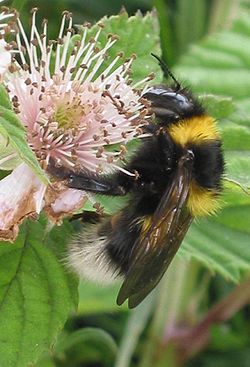This is an old revision of this page, as edited by 24.90.103.80 (talk) at 07:23, 27 September 2004. The present address (URL) is a permanent link to this revision, which may differ significantly from the current revision.
Revision as of 07:23, 27 September 2004 by 24.90.103.80 (talk)(diff) ← Previous revision | Latest revision (diff) | Newer revision → (diff)Template:Taxobox begin Template:Taxobox image Template:Taxobox begin placement Template:Taxobox regnum entry Template:Taxobox phylum entry Template:Taxobox subphylum entry Template:Taxobox classis entry Template:Taxobox subclassis entry Template:Taxobox infraclassis entry Template:Taxobox superordo entry Template:Taxobox ordo entry Template:Taxobox subordo entry Template:Taxobox superfamilia entry Template:Taxobox familia entry Template:Taxobox subfamilia entry Template:Taxobox genus entry Template:Taxobox end placement Template:Taxobox section subdivision see text Template:Taxobox end
The bumblebee is a flying insect of the genus Bombus in the family Apidae. Like the common honeybee, of which it is a distant relative, the bumblebee feeds on nectar and gathers pollen to feed its young. They are very interesting creatures that are beneficial to humans and the plant world alike, and tend to be larger than other members of the bee family. Most, but not all, bumblebee species are gentle. From this comes their original name: "Humblebee".
Bumblebees are social insects that are characterized by black and yellow striped body, a commonality among the majority of the species of Bombus; however, some species are known to have orange or even red on their bodies. Another distinguishing characteristic a hairlike substance that covers their abdomens, making them appear fuzzy.
A long-held myth of the bumblebee was that, in terms of sheer aerodynamics, it did not have the capacity (in terms of wing size or beat per second) to achieve flight. This myth became popular after an aerodynamicist in the 1930's stated that a bumblebee was not capable of flight. The statment was based upon an assumption that the bee's wing was a smooth plane. The statement held for several weeks, creating major ripples in the media, until the aerodynamicist finally examined the insect's wing under a microscope. Finding that his initial assumption was very wrong, he put out a retraction. Although the papers dropped the original story, they only printed the retraction in a very small article near the back of the paper - thus, most readers missed the retraction, and the myth survived.
Bumblebees are typically found in higher elevations that range from warm to cool climates where other bees would not be found. One reason for this is that bumblebees are one of the few insects that can regulate their body temperature.
Bumblebees live in hives like honeybees. However, their hives are usually found in hollow underground spaces, such as abandoned rodent dwellings, where they will raise larvae and store food. They may also nest in birdhouses, bales of hay, or building walls. They particularly like the stuffing of old furniture or car seats and may thus move into junked cars or dumped upholstered furniture.
Unlike honeybees, bumblebees only store a few days' worth of food and so are much more vulnerable to food shortages. Bumblebees mostly do not preserve their nests through the winter, some tropical species live in their nests for some years. The last generation of summer includes a number of queens who overwinter separately in protected spots.
In the autumn, young queens mate with male drone bees and hibernate over the winter in a warm area. Oftentimes, a queen will burrow into the ground to keep herself from freezing. In the spring, a queen awakens and finds a suitable place to create her hive, and then builds wax pots in which to lay her fertilized eggs from the previous winter. The eggs that hatch are female workers, and in time they populate the hive.
Bumblebees are beneficial to human beings because they can operate their hives at cooler temperatures than other species of bee. Farmers in colder climates often use bumblebees to pollinate their crops. However, bumblebees are not used to produce honey because their yield is not as large as that of the honeybee.
Bumblebees are in danger in many developed countries due to habitat destruction and collateral pesticide damage. In Britain, there are 21 species of native bumblebee and six varieties of cuckoo bees — bees that dupe other bumblebees into looking after their young. Of these, only six bumblebees remain widespread; five are in serious decline and at least three are extinct.
Common species of Bumblebee include:

- Small Garden bumblebee, Bombus hortorum
- Large Garden bumblebee, Bombus ruderatus
- Cullem's bumblebee, Bombus collamanus
- Short-haired bumblebee, Bombus subterraneus
- Great Yellow bumblebee, Bombus distinguendus
- Shrill Carder bee, Bumbus silvarum
Bumblebees are increasingly cultured and used for pollination. They are the pollinator of choice for modern greenhouse tomatoes and some other crops.
See also

Further reading
- Harman, Alan. "Bumblebee Shortage". Bee Culture, 59. July, 2003.
- "Bees." World Book Encyclopedia. 1998 ed.
- Hasley, William D. "Bees." Collier's Encyclopedia. 1990 ed.
- Abbott, Carl, and Bartlett, John. "Bumble Bees." Encarta Encyclopedia. 2004 ed.
- Freeman, Scott. Biological Science. New Jersey: Upper Saddle River, 2002.
External links
- The Bumblebee Pages (Europe)
- Alternative pollinators Also links to non-apis vendors.
- Do your own pest control: Bumble bees
- Bumble Bees: Bombus Bimaculatus